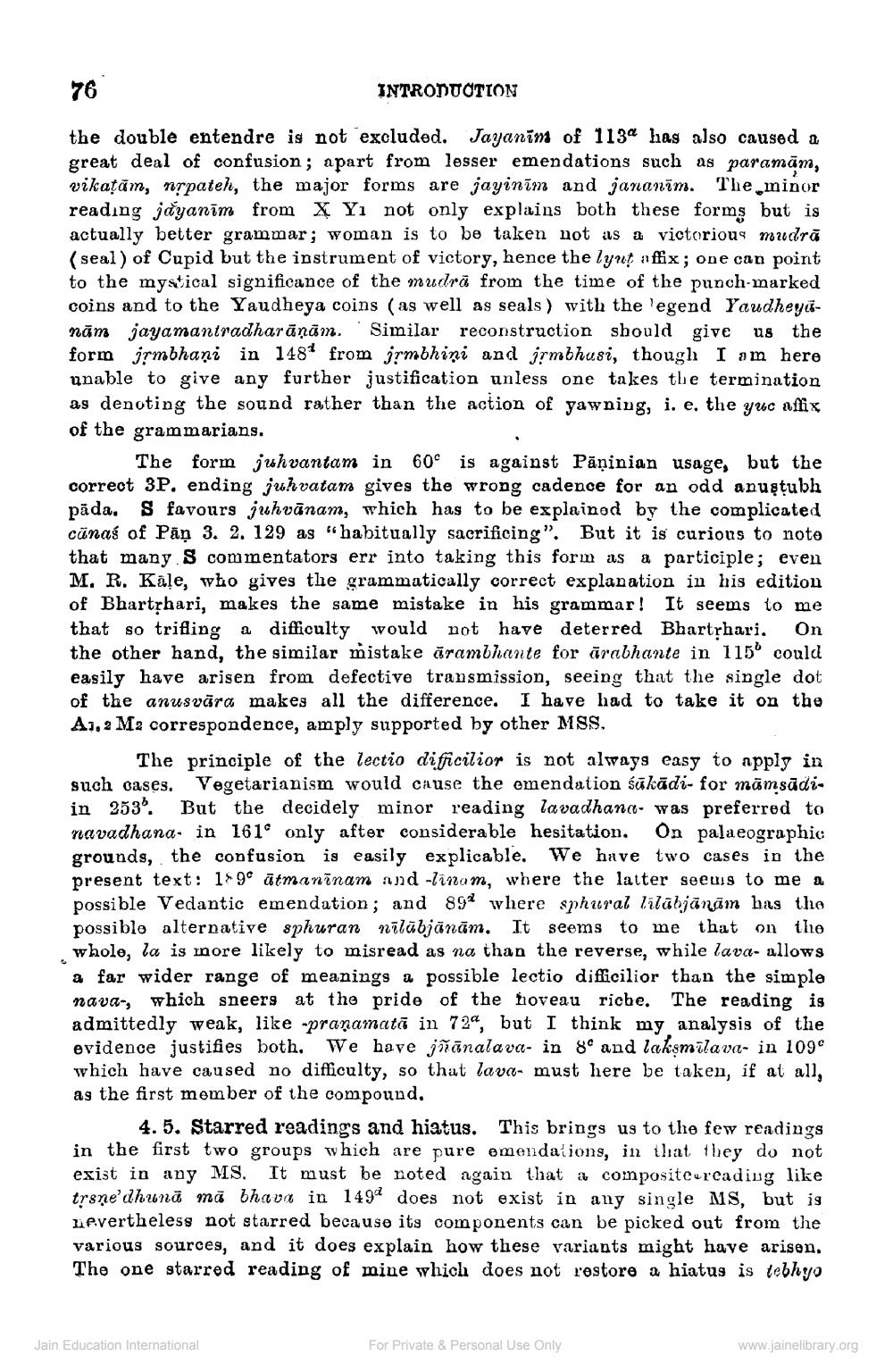________________
76
INTRODUCTION
the double entendre is not excluded. Jayaning of 1134 has also caused a great deal of confusion; apart from lesser emendations such as paramām, vikatām, nrpateh, the major forms are jayinīm and jananim. The minor reading jayanim from X Yı not only explains both these forms but is actually better grammar; woman is to be taken not as a victorious mudră (seal) of Cupid but the instrument of victory, hence the lyut affix; one can point to the mystical significance of the mudră from the time of the punch-marked coins and to the Yaudheya coins (as well as seals) with the legend Yaudheyanām jayamantradharāņām.. Similar reconstruction should give us the form jrmbhani in 1487 from jrmbhiņi and irmbhusi, though I am here unable to give any further justification unless one takes the termination as denoting the sound rather than the action of yawning, i, e. the yuc affix of the grammarians.
The form juhvantam in 60° is against Pāṇinian usage, but the correct 3P. ending juhvatam gives the wrong cadence for an odd anuştubh păda. S favours juhvānam, which has to be explained by the complicated cānas of Pāņ 3. 2. 129 as "habitually sacrificing". But it is curious to note that many s commentators err into taking this form as a participle; even M. R. Kale, who gives the grammatically correct explanation in his edition of Bhartrhari, makes the same mistake in his grammar! It seems to me that so trifling a difficulty would not have deterred Bhartrhari. On the other hand, the similar mistake ārambhante for ārabhante in 115° could easily have arisen from defective transmission, seeing that the single dot of the anusvāra makes all the difference. I have had to take it on the A1,2 M2 correspondence, amply supported by other MSS.
The principle of the lectio difficilior is not always easy to apply in such cases. Vegetarianism would cause the emendation sūkādi- for māmsādi. in 253'. But the decidely minor reading lavadhana was preferred to navadhana. in 161o only after considerable hesitation. On palaeographic grounds, the confusion is easily explicable. We have two cases in the present text: 1% 9° ātmaninam and linom, where the latter seems to me a possible Vedantic emendation; and 898 where sphural lilābjānām has the possible alternative sphuran Nīlābjänām. It seems to me that on the whole, la is more likely to misread as na than the reverse, while lava- allows a far wider range of meanings a possible lectio difficilior than the simple nava-, which sneers at the pride of the hoveau riche. The reading is admittedly weak, like -pranamatā in 72", but I think my analysis of the evidence justifies both. We have jñānalava- in 8o and laksmilava- in 1090 which have caused no difficulty, so that lava- must here be taken, if at all, as the first member of the compound.
4.5. Starred readings and hiatus. This brings us to the few readings in the first two groups which are pure emendations, in that they do not exist in any MS. It must be noted again that a compositeurcading like trsne' dhunä mä bhava in 149d does not exist in any single MS, but is levertheless not starred because its components can be picked out from the various sources, and it does explain how these variants might have arisen. The one starred reading of mine which does not restore a hiatus is tebhyo
Jain Education International
For Private & Personal Use Only
www.jainelibrary.org




